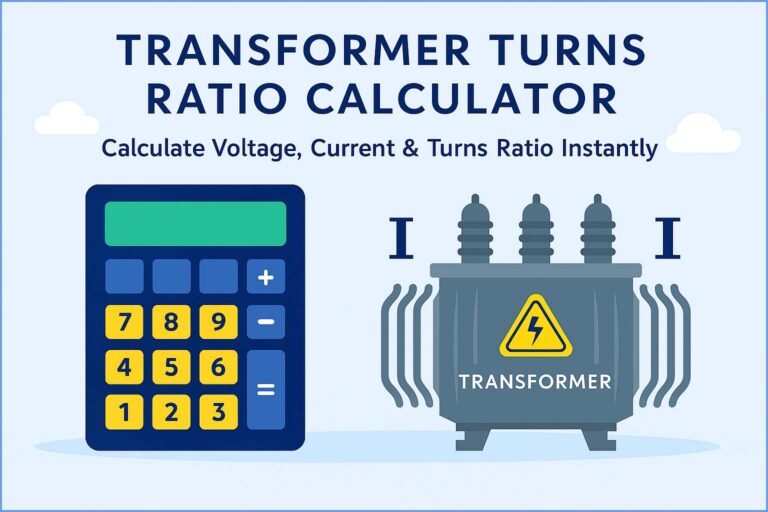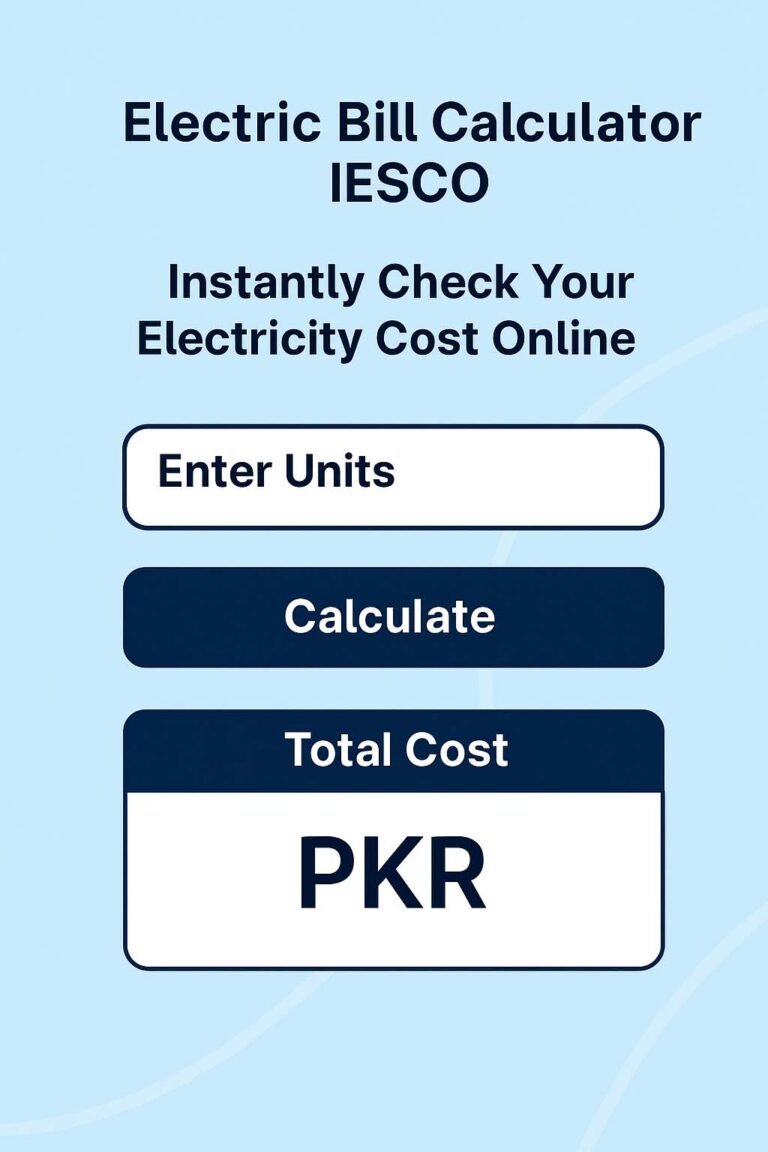Short Circuit Current Calculator for Transformers: Best Tool
Short circuit calculations are critical for transformer protection. When a fault occurs, massive amounts of current flow through the system. This high current, called the short circuit current, can damage equipment, cables, and transformers if not managed correctly.
To avoid such failures, engineers perform short circuit studies during the design and installation phases. These studies help to size protective devices like circuit breakers and fuses. And at the core of these studies lies the Short Circuit Current Calculator for Transformers—a powerful tool that simplifies fault current calculations.
Table of Contents

This calculator is a must-have for electrical engineers, utility companies, and maintenance personnel. It allows quick and accurate computation of fault currents at different points in the power system. Whether you’re working on a distribution substation or a large industrial setup, knowing how to use a fault current calculator can save time, prevent accidents, and improve system reliability.
Key Takeaways
- Short circuit current is the maximum current expected to flow during a fault.
- Transformers play a key role in determining how this current behaves.
- A Short Circuit Current Calculator for Transformers helps identify the required protection settings and cable ratings.
- Correct calculation ensures transformer protection and power system safety.
Why Short Circuit Calculation is Important
In a fault condition—such as line-to-ground, line-to-line, or three-phase short—very high currents can flow. These currents can reach levels 10 to 25 times the full-load current of the transformer. Without adequate protection, the system components could overheat, arc, or even explode.
That’s where short circuit calculation comes in. By determining how much current will flow during a fault, engineers can design a system that can handle it safely. These calculations influence:
- Protection relay settings
- Circuit breaker interrupt ratings
- Busbar and cable sizes
- Coordination of protective devices
Use our online tool for free Short Circuit Current Calculator
Understanding Fault Current in Transformers
Transformers are energy transfer devices. They also contribute to fault currents because of their low impedance. The amount of current a transformer will supply during a short circuit depends on:
- Its impedance (in percent or per unit)
- Its power rating (in kVA or MVA)
- The system voltage (in volts)
The fault current calculator uses these values to calculate the short circuit current on the secondary side of the transformer. Here’s the fundamental formula used in such calculators:

This is for a three-phase system. For a single-phase system, remove the √3 term.
Example Calculation Using Fault Current Calculator
Let’s take a simple example.
- Transformer Rating = 1000 kVA
- Voltage (line-to-line) = 11,000 V
- Impedance = 5%
Applying the formula:

So, during a three-phase fault, the short circuit current would be approximately 1049.7 Amps.
Use our online tool for free Wire Size Calculator for Subpanels and Feeders – NEC Guidelines Included
Table: Typical Transformer Impedance Values
| Transformer Size (kVA) | Voltage (kV) | Typical % Impedance |
|---|---|---|
| 100 | 11/0.4 | 4.5% – 6.0% |
| 500 | 11/0.4 | 5.0% – 6.5% |
| 1000 | 11/0.4 | 5.5% – 7.0% |
| 2500 | 33/0.4 | 6.0% – 8.0% |
These values are approximate and may vary depending on the manufacturer and the application.
How to Use a Short Circuit Current Calculator for Transformers
Modern calculators—like those built into electrical software or web-based platforms—only need you to input three values:
- Transformer kVA/MVA rating
- Voltage level (primary or secondary)
- Impedance percentage
The tool then instantly calculates the fault current. Some advanced versions allow for additional inputs, such as X/R ratio, fault type (L-G, L-L, 3-Ph), and distance from the transformer.
For example, a short circuit current calculator for transformers may also calculate the momentary current, interrupting current, and symmetrical RMS current. These help select the proper circuit breaker ratings.
Use our online tool for free Amps to Wire Size Calculator
Factors Influencing Short Circuit Currents
Besides transformer impedance, these factors also affect the short circuit calculation:
- Length of the cable between transformer and fault point (affects impedance)
- Type of fault (e.g., single-line-to-ground faults generate different currents than three-phase faults)
- X/R ratio, which affects the DC offset and peak asymmetrical current
- System grounding method (solid, resistance, or reactance grounding)
These parameters are especially important in medium to high-voltage systems.
Advantages of Using a Fault Current Calculator
Using a fault current calculator brings several advantages:
- Speed: Instant results compared to manual calculations.
- Accuracy: Reduces human error.
- Safety: Helps in better protective device coordination.
- Design optimization: Avoids over-sizing or under-sizing equipment.
- Compliance: Meets regulatory standards such as IEEE 242, IEC 60909, and NEC 110.9.
Use our online tool for free Wire Size Calculator for Solar Panels
Design Implications of Fault Current Calculations
Here’s where the real value lies. Once the short circuit current is known, you can:
- Set your relay trip points just above load current and below fault current
- Select a breaker with the correct interrupting capacity
- Choose CT and PT ratings suitable for both metering and protection
- Ensure your grounding system can handle the prospective fault
These decisions directly impact system reliability and equipment lifespan.
Practical Tips for Engineers
- Always verify transformer impedance values from the nameplate or datasheet.
- Use conservative estimates if exact cable lengths are unknown.
- Don’t forget to include source impedance if you’re analyzing the upstream system.
- Update your short circuit studies after major modifications in the system.
- Document your assumptions clearly when using any short circuit current calculator for transformers.
Use our online tool for free Free Electrical Wire Size Chart & Calculator
Comparison: Manual vs. Software-Based Short Circuit Calculations
| Aspect | Manual Calculation | Software/Calculator Tool |
|---|---|---|
| Time Required | High | Low |
| Risk of Error | Medium to High | Low |
| Required Inputs | Detailed | Minimal |
| Suitability for Complex Systems | Poor | Excellent |
| Best Use Case | Small systems or learning | Large systems and practical use |
Final Thoughts
The Short Circuit Current Calculator for Transformers is more than just a convenient tool—it’s an essential part of modern electrical design. Without it, determining safe and efficient protection schemes becomes guesswork. With it, engineers can optimize protection, ensure safety, and meet compliance requirements.
It’s important to remember that while calculators provide fast results, they should always be used with sound engineering judgment. The inputs must be accurate, and the interpretation must be informed by experience.
Follow Us on Social:
Subscribe our Newsletter on Electrical Insights for latest updates from Electrical Engineering Hub
#ShortCircuitCalculation, #TransformerFaultCurrent, #ElectricalCalculator, #PowerSystemProtection, #TransformerProtection, #FaultCurrentCalculator, #ElectricalEngineering, #ShortCircuitCurrent, #TransformerDesign, #IndustrialElectrical, #SubstationDesign, #RelayCoordination, #ProtectionEngineering, #ElectricalSafety, #SmartGridEngineering
Short Circuit Current Calculator for Transformers: Best Tool : Electrical Engineering Hub

Easily calculate short circuit current for transformers using our free online Short Circuit Current Calculator for transformers. Ideal for engineers and students, it helps in transformer protection, fault current analysis, and electrical safety planning
Price Currency: USD
Operating System: All
Application Category: UtilitiesApplication






